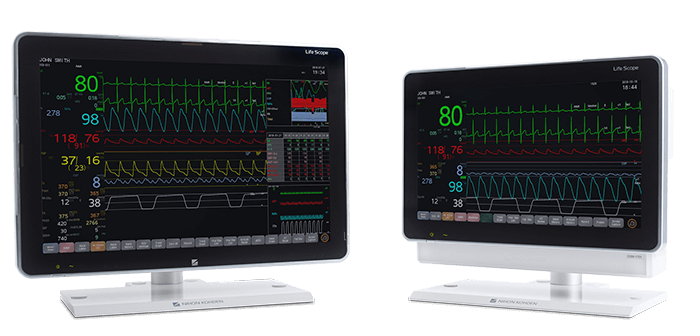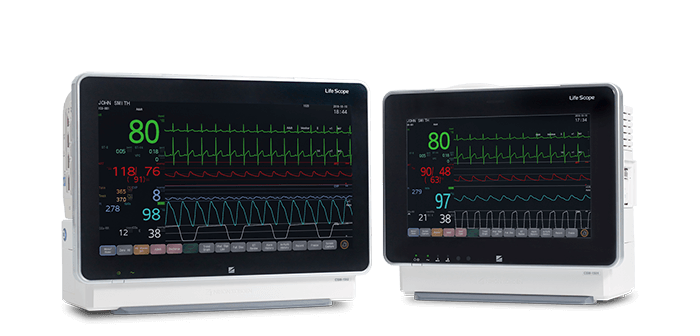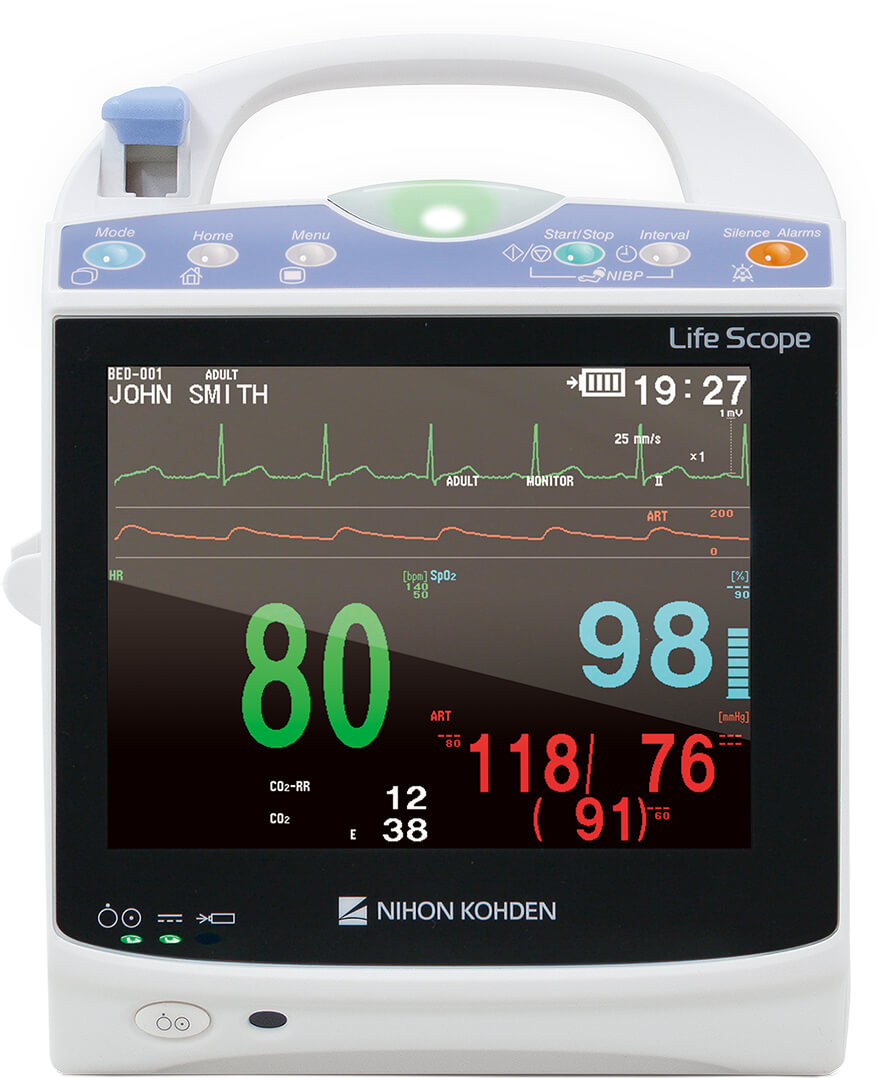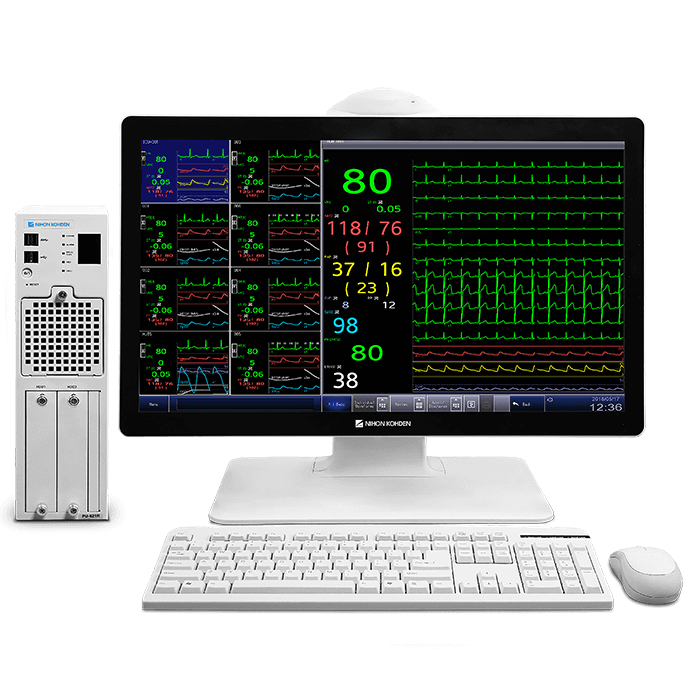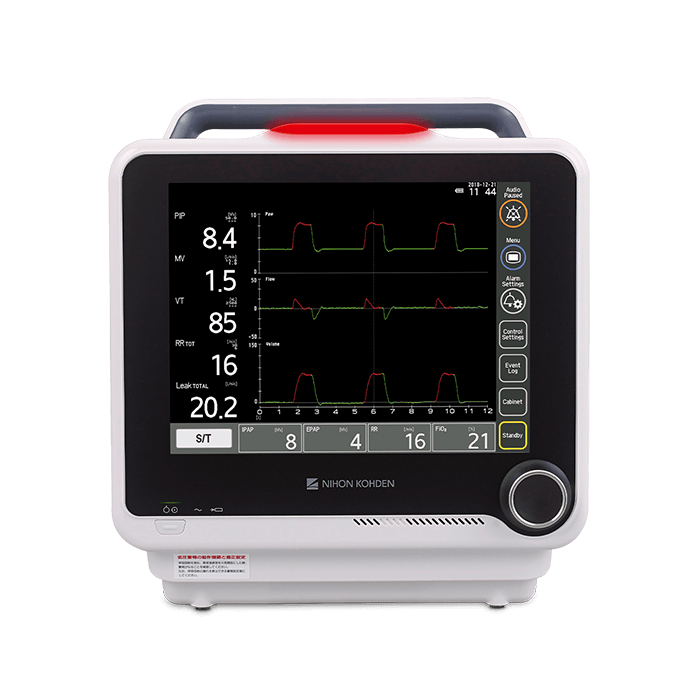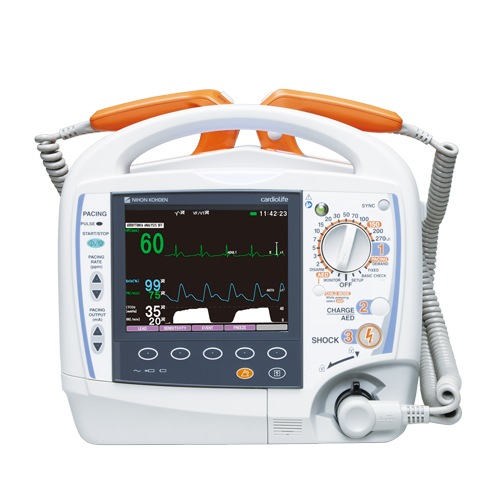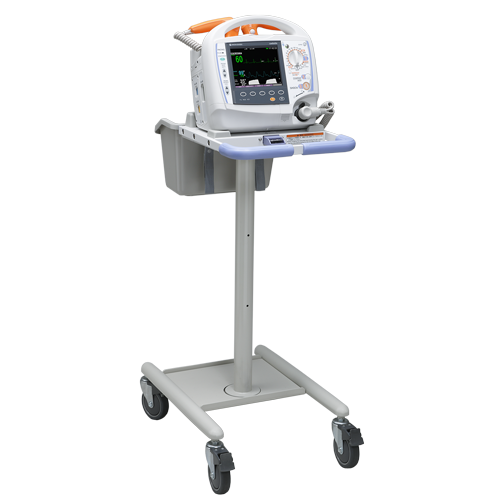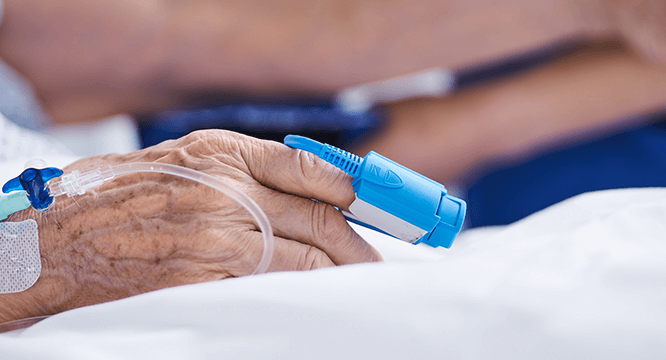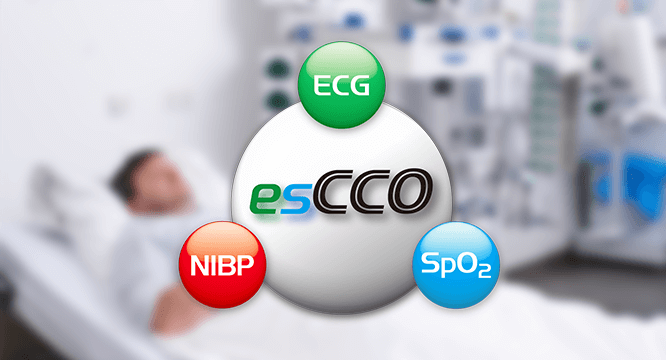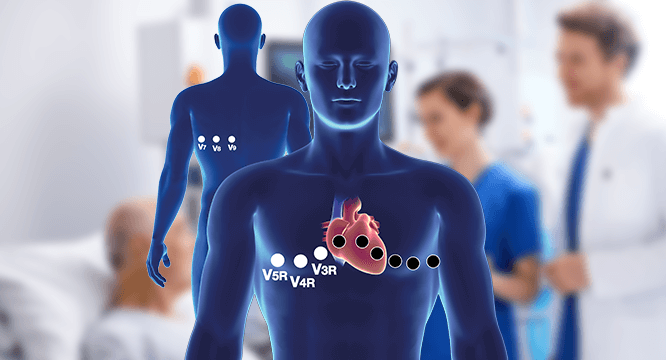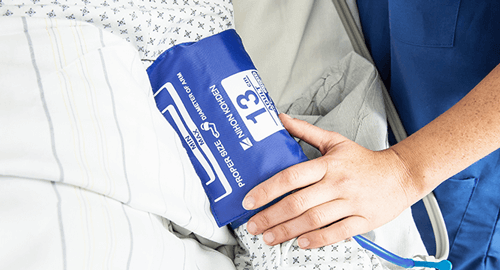
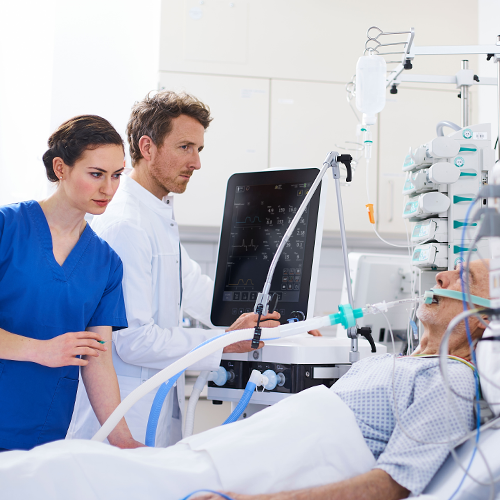
Cuidados Intensivos
¿Está buscando información sobre un producto específico? Tenga en cuenta que esta página web todavía está siendo traducida y algunos contenidos pueden aparecer en su idioma original. Estamos trabajando para completar las traducciones y agradecemos su comprensión.
La detección temprana y la intervención oportuna son críticas para proporcionar cuidados intensivos efectivos. Para los pacientes gravemente enfermos, la monitorización segura es esencial para evaluar de manera integral diversas condiciones del paciente. Aprovechando la tecnología única de Nihon Kohden, transformamos lo invisible en datos visibles en los monitores e integramos estos datos de manera fluida utilizando nuestro avanzado concepto de transporte. Cuando se combinan con los ventiladores y desfibriladores de Nihon Kohden, podemos proporcionar una monitorización y tratamiento eficientes en entornos de cuidados intensivos. Los datos del paciente recopilados a través de la monitorización se distribuyen e integran sin problemas en las ubicaciones necesarias y los sistemas hospitalarios, siguiendo un protocolo común. Este enfoque optimizado garantiza una gestión eficiente de los datos del paciente, mejorando en última instancia los resultados del paciente.
Mejorando los Cuidados Intensivos: Monitorización al Pie de Cama con Nihon Kohden Life Scope G5 y G7
Los Nihon Kohden Life Scope G5 y G7 están diseñados para adaptarse a una amplia gama de entornos clínicos. Ofrecen registros completos de datos de pacientes, con divulgación completa de múltiples formas de onda y parámetros, e integración sin problemas con dispositivos de terceros. Estos monitores están equipados con funciones avanzadas como cálculos de medicamentos y pulmonares, gráficos hemodinámicos y análisis avanzado de ECG.
Están meticulosamente diseñados para mejorar la atención centrada en el paciente, reducir significativamente las falsas alarmas y disminuir la carga de trabajo y el tiempo de diagnóstico. La serie Life Scope es sinónimo de atención centrada en el paciente de alta calidad, tecnologías de vanguardia y transporte de pacientes sin problemas. Estos monitores representan el compromiso de Nihon Kohden de mejorar los resultados de los pacientes y aumentar la eficiencia de los proveedores de atención médica.
Monitorización continuo de pacientes durante el transporte
El Lifescope PT de Nihon Kohden es un monitor de transporte versátil que garantiza una atención de alta calidad durante el transporte del paciente, independientemente de la condición o ubicación del paciente. Puede funcionar de manera independiente o como parte de un sistema de monitorización empresarial. Cuando se conecta a un monitor de cabecera de Nihon Kohden, sirve como dispositivo de entrada y monitor de transporte. Para el transporte, el Life Scope se desconecta del monitor de cabecera, proporcionando capacidades de monitorización completas. Al llegar al nuevo entorno de atención y reconectarse a un monitor anfitrión, los datos del paciente, incluido el Full Disclosure, los archivos de recuperación de arritmias, las tendencias y los datos de ST, se cargan automáticamente en el sistema de monitorización empresarial, creando un registro del paciente sin interrupciones.
La solución hemodinámica - Seguridad del paciente en todos los niveles
La unidad hemodinámica de Nihon Kohden es un módulo que combina por primera vez dos tecnologías innovadoras para mediciones hemodinámicas en un solo dispositivo para proporcionar revisiones de datos inteligentes. Una solución integral que ofrece toda la gama de monitoreo hemodinámico con monitores de cabecera Nihon Kohden, incluidos PiCCO y ProAQT, para enfrentar los desafíos de cada nivel de gravedad.
La sinergia de Central Station y NK-HiQ
Como el corazón del Sistema de Monitoreo de Pacientes de Nihon Kohden, la Central Station Life Scope proporciona monitoreo y revisión integral de pacientes de hasta 32 pacientes utilizando dos pantallas. El sistema completo está diseñado para garantizar que los datos críticos estén siempre disponibles para cada paciente durante toda su estancia en el hospital. La Central Station también respalda un registro completo del paciente facilitando la transferencia de datos del paciente entre múltiples departamentos. Muchas de las funciones de la Central Station Life Scope también se pueden acceder utilizando la solución de gateway, que permite la monitorización secundaria de hasta 16 pacientes. Juntos, la Central Station Life Scope y NK-HiQ ofrecen un monitoreo de pacientes potente de manera inteligente, segura y protegida.
SmartLink: Un sistema eficiente de gestión de alarmas
SmartLink, el innovador sistema de gestión de alarmas de Nihon Kohden, transforma los entornos de cuidados críticos al mejorar el flujo de trabajo clínico, reducir la fatiga por alarmas y mejorar la seguridad del paciente. Diseñado para los entornos médicos acelerados de hoy en día, SmartLink envía alertas críticas y precisas directamente a los dispositivos móviles de los cuidadores, permitiendo respuestas rápidas e informadas. Los ajustes personalizables del sistema ayudan a priorizar las notificaciones esenciales, minimizando la distracción de mensajes irrelevantes. Al agilizar los procesos y filtrar las alarmas redundantes, SmartLink permite a los médicos y enfermeras centrarse en tareas vitales, aumentando la eficiencia y la productividad. Esto conlleva beneficios económicos significativos, como estancias de pacientes reducidas y menores costos operativos.
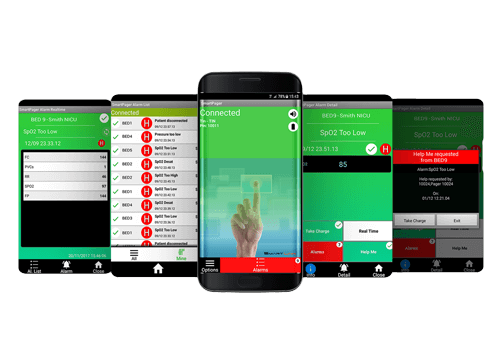
Soluciones integrales de ventilación en cuidados críticos por Nihon Kohden
La línea de productos de ventilación de Nihon Kohden, que incluye los sistemas NKV-330, NKV-440 y NKV-550, ofrece soluciones integrales para entornos de cuidados críticos. Estos sistemas permiten transiciones fluidas entre modos de ventilación invasiva y no invasiva, terapia de oxígeno de alto flujo y ofrecen una gama de características de confort para el paciente. Están equipados con capacidades avanzadas de monitoreo, asegurando el acceso en tiempo real a datos vitales del paciente. Los sistemas también incorporan medidas de seguridad como la protección de filtro HEPA dual y la notificación inmediata de eventos críticos del ventilador. Con su adaptabilidad, eficiencia y enfoque en la seguridad del paciente, los ventiladores de Nihon Kohden son herramientas valiosas para los profesionales de la salud en cuidados críticos.
Soporte en cuidados críticos con el cardiolife TEC-5600
El Nihon Kohden cardiolife TEC-5600 es un monitor/desfibrilador diseñado para cuidados críticos. Cuenta con una pantalla TFT LCD de 6.5 pulgadas para una rápida confirmación de datos y un sistema Smart Cable™ para un fácil intercambio de sensores. Su rápida entrega de choque y capacidades de observación continua, junto con una forma de onda bifásica para una desfibrilación efectiva, mejoran la atención al paciente. El dispositivo también admite la estimulación no invasiva y ofrece un análisis mejorado de arritmias con el sistema ec1. Su diseño compacto y ligero lo hace ideal para el transporte, convirtiéndolo en una herramienta valiosa en entornos de cuidados críticos.

El oxímetro de pulso, inventado por el Dr. Takuo Aoyagi en 1972, monitoriza de manera no invasiva los niveles de oxígeno en el torrente sanguíneo. BluPro, una tecnología de oximetría de pulso, incorpora el algoritmo NPi para una filtración única que elimina los artefactos. Esto asegura mediciones fiables y precisas incluso en condiciones de baja perfusión o durante el movimiento, mejorando así la monitorización del paciente.

El cap-ONE de Nihon Kohden es un sensor de CO2 de flujo principal diseñado tanto para pacientes intubados como no intubados. Ofrece mediciones precisas mientras reduce la carga sobre los pacientes. Esta tecnología supera las desventajas de los sensores de flujo principal, proporcionando una capnografía óptima. Es particularmente beneficioso en entornos de cuidados críticos, donde la monitorización continua y precisa del CO2 es esencial.

La adición de esCCO a la monitorización convencional de pacientes puede llevar a la optimización del manejo de fluidos, la disminución del riesgo de complicaciones y, eventualmente, a mejores resultados, incluyendo una reducción en la duración de la estancia. esCCO proporciona información sobre el gasto cardíaco utilizando solo parámetros comunes de signos vitales como ECG, SpO2 y presión arterial, sin necesidad de sensores adicionales o entrenamiento especial. La monitorización de tendencias hemodinámicas estará disponible con esCCO para todos los niveles de atención, no solo durante cirugías mayores, sino también en procedimientos de menor riesgo para pacientes de alto riesgo que muestren una mayor probabilidad de sangrado o cualquier estrés hemodinámico.

La tecnología synECi18 utiliza las formas de onda estándar de ECG de 12 derivaciones para derivar matemáticamente formas de onda adicionales, proporcionando más información sobre la condición del corazón. Es particularmente útil en la detección de infartos del lado derecho y posteriores, mejorando las capacidades diagnósticas de las máquinas de ECG.

La tecnología iNIBP (intelligent Non-Invasive Blood Pressure) de Nihon Kohden ofrece una monitorización continua y precisa de la presión arterial. Es una tecnología de medición de presión arterial no invasiva que utiliza un método de medición de inflación lineal para completar la medición mientras se infla el manguito. Esto reduce la incomodidad del paciente y proporciona resultados más rápidos, mejorando la experiencia del paciente y la eficiencia clínica.
